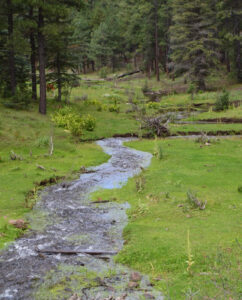Prepared By: Steve La Falce
 One acre of trout stream bottom can produce 100 pounds of nymphs and larvae, the favorite food for trout. A really productive stream can produce 200 pounds per bottom acre!
One acre of trout stream bottom can produce 100 pounds of nymphs and larvae, the favorite food for trout. A really productive stream can produce 200 pounds per bottom acre!
Insects that trout eat spend all but a few days of their lives under water. The Mayflies, Stoneflies and Caddis flies are totally aquatic Mayflies and stoneflies in the immature stages of life are called NYMPHS while caddis flies are properly called LARVAE but fisherman call them nymphs as well.
Caddis flies (some 1200 species in North America) have a COMPLETE life cycle consisting of stages called egg, larva, pupa and adult.
Mayflies (700 species in NA) and stoneflies (close relatives of cockroaches, 500 species in NA) have what is called an INCOMPLETE life cycle of stages called egg, nymph and adult. The nymph has a HEAD, with “feelers” and eyes, a THORAX with six legs and developing wing cases, an ABDOMEN consisting of several segments, and two or three tails, depending on the species.
When the mayflies and stoneflies “hatch”, that is, turn into adult (called sub-imago) insects, the wing cases split open and the adult emerges from the “shell”.
Trout eat larvae, nymphs and adults. The splashes you see on the surface are trout having a meal!
Nymphs and larvae breathe through gills. Mayfly gills are found along the sides of the abdomen. Stonefly gills re under the thorax. Caddis fly gills are hair-like filaments along the entire body. When the adult (imago) insect deposits its eggs in the water the eggs begin growing and dividing as they get bigger. The nymph and larval stages go through several moultings, periods between which are called “instars”, before they hatch, sometimes 20 or more. Mayflies go through one more moult as they turn from sub-imagoes to the egg laying imagoes.
PLECOPTERA (Stoneflies)
Swifter water, riffles, runs
One half to 2 inches long
Prominent tails and “feelers”
Twin sets of wing cases
Hairy gills under thorax
Two claws on each foot
Adults have two pairs of wings
Fly with body in vertical position
Wings folded flat over body when resting
TRICHOPTERA (Caddis flies)
One quarter to 2 inches long
Pale worms with “hooks” at the end of their bodies
Dark heads
Six legs attached to dark thorax
Hairy gills along abdomen
Larval stage stay sealed except for trickle of water
Swift water types swim to surface and emerge from pupal skin
Slow water species crawl to shallows and emerge like stoneflies
Pupae migrate to surface and emerge en-masse
Wings fold in an upside down “V”, like a pup tent, when at rest
EPHEMEROPTERA (Mayflies)
Trout favorites
Three types of nymphs: burrowing, clinging and crawling/swimming
20 instars
Most nymphs have 3 tails
Restless before emergence, alerting trout and birds
At surface skin splits and DUN (imago) emerges, floats several feet
while wings stiffen
Moults again after flying to bushes
Reappears over water as SPINNER (imago) to mate a deposit eggs
Has four wings but rear set are small
Wings held erect while resting
OTHER INSECTS
Midges
Terrestrials
Suggestions for further reading:
Matching the Hatch, Ernest Schweibert, Macmillan, New York, 1955
Nymphs, Ernest Schweibert, Winchester Press, New York, 1973
Aquatic Entomology, W. Patrick McCafferty, Science Books, Boston, 1981
Fishing the Nymph, Jim Quick, Ronald Press, New York, 1960


